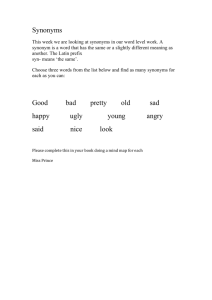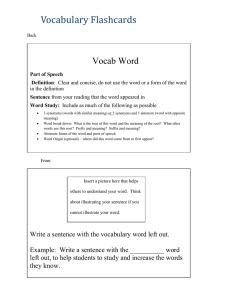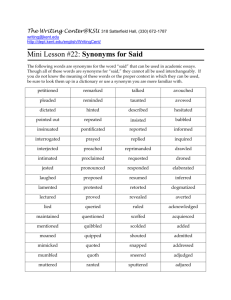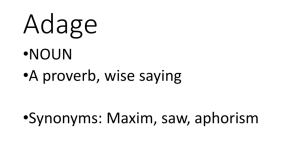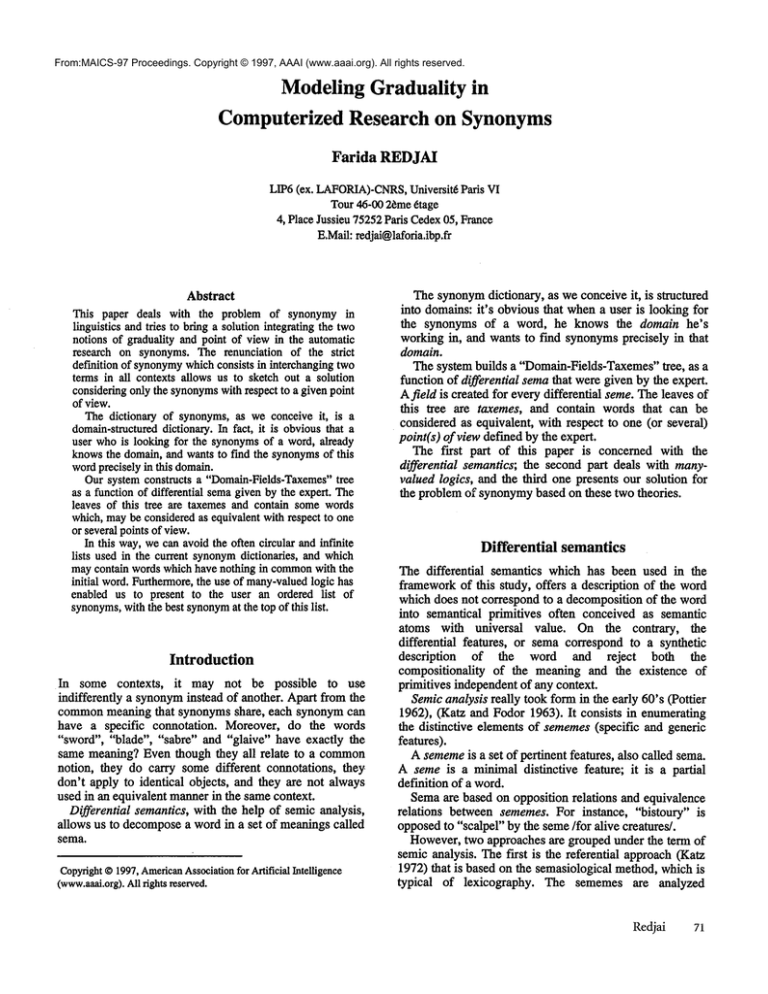
From:MAICS-97 Proceedings. Copyright © 1997, AAAI (www.aaai.org). All rights reserved.
Modeling Graduality in
Computerized Research on Synonyms
Farida REDJAI
LIP6 (ex. LAFORIA)-CNRS,
Universit6 Paris
Tour 46-00 2~me6tage
4, Place Jussieu 75252Paris Cedex05, France
E.Mail:redjal@laforia.ibp.fr
Abstract
This paper deals with the problem of synonymyin
linguistics andtries to bringa solutionintegratingthe two
notions of graduality and point of view in the automatic
research on synonyms.The renunciation of the strict
definition of synonymy
whichconsists in interchangingtwo
terms in all contexts allows us to sketch out a solution
consideringonly the synonyms
with respect to a given point
of view.
The dictionary of synonyms,as we conceive it, is a
domain-structured
dictionary. In fact, it is obviousthat a
user whois looking for the synonymsof a word, already
knowsthe domain,and wants to find the synonyms
of this
wordprecisely in this domain.
Our systemconstructs a "Domain-Fields-Taxemes"
tree
as a functionof differential semagiven by the expert. The
leaves of this tree are taxemesand contain somewords
which,maybe consideredas equivalent with respect to one
or several pointsof view.
In this way,we canavoidthe often circular and infinite
lists used in the current synonym
dictionaries, and which
maycontain wordswhichhave nothing in common
with the
initial word.Furthermore,the use of many-valued
logic has
enabled us to present to the user an ordered list of
synonyms,
withthe best synonym
at the top of this list.
Introduction
In some contexts,
it may not be possible to use
indifferently a synonyminstead of another. Apart from the
commonmeaning that synonyms share, each synonym can
have a speeifie connotation. Moreover, do the words
"sword", "blade", "sabre" and "glaive" have exactly the
same meaning? Even though they all relate to a common
notion, they do carry some different connotations, they
don’t apply to identical objects, and they are not always
used in an equivalent mannerin the samecontext.
Differential semantics, with the help of semic analysis,
allows us to decomposea word in a set of meaningscalled
sema.
Copyright
©1997,American
Association
for Artificial Intelligence
(www.aaai.org).
Allfightsreserved.
The synonymdictionary, as we conceive it, is structured
into domains: it’s obvious that whena user is looking for
the synonyms of a word, he knows the domain he’s
working in, and wants to fred synonymsprecisely in that
domain.
The system builds a "Domain-Fields-Taxemes"
tree, as a
function of differential semathat were given by the expert.
Afield is created for every differential seme. The leaves of
this tree are taxemes, and contain words that can be
considered as equivalent, with respect to one (or several)
point(s) of view defined by the expert.
The first part of this paper is concerned with the
differential semantics; the second part deals with manyvalued logics, and the third one presents our solution for
the problem of synonymybased on these two theories.
Differential semantics
The differential semantics which has been used in the
frameworkof this study, offers a description of the word
which does not correspond to a decomposition of the word
into semantical primitives often conceived as semantic
atoms with universal value. On the contrary, the
differential features, or sema correspond to a synthetie
description
of the word and reject
both the
compositionality of the meaning and the existence of
primitives independentof any context.
Semicanalysis really took form in the early 60’s (Pottier
1962), (Katz and Fodor 1963). It consists in enumerating
the distinctive elements of sememes(specific and generic
features).
A sememeis a set of pertinent features, also called sema.
A seme is a minimal distinctive feature; it is a partial
definition of a word.
Semaare based on opposition relations and equivalence
relations between sememes. For instance, "bistoury" is
opposedto "scalpel" by the seme/for alive creatures/.
However,two approaches are grouped under the term of
semic analysis. The first is the referential approach (Katz
1972) that is based on the semasiological method, which is
typical of lexicography. The sememes are analyzed
Redjai
71
according to their differences inside a class constituted by
an expression criterion. For instance, if we regroup in a
same class the sememeshaving for expression "plane", we
necessarily have to inter-def’me "plane1" (aeroplane) and
"plane2" (carpenter tool), which have the same spelling.
The second approach is the differential approach (Pottier
1962), (Coseriu 1976). It adopts an onomasiologieal
method. The sememes are analyzed according to their
differences inside a minimalsemantic class (the taxeme),
constucted from one strictly semantical criterion. For
example, the class of "furniture" and the class of
"transportation means"
For differential semantics, the numberand the nature of
the componentsof a sememeare directly related to the
number and the nature of the components of the other
sememescontainedin its def’mition class.
Onthe contrary, for the referential semantics, there’s no
linguistic criterion whichallows to choosethe components,
nor to limit their number. For instance, the "chair" is
defined by 4 features in (Pottier 1974), and by I0 features
in (Katz 1972).
Any semic analysis must of course solve the crucial
problemsof identification of features, and the limitation of
their number.
Only the methodof differential analysis can solve the
problemof relevance of the components,since it operates
on classes of words built according to linguistic criteria,
but not on isolated words,k, ~id~, ~o def~.~ie themrelatively
to their referents.
Algebrical structure
The many-valuedlogic is a generalization of the Boolean
logic. It uses a finite and totally ordered De Morganlattice
LM
" {’~,’~2.......... ,%a}of truth-degrees(%___"Cj iff i _< j)
going from"~t ("not at all") to ~ ("totally"), supplied
the v, ^, and - operators (Akdag1992), (Akdag, De Glas
and Pacholczyk 1992)
Let us chooseLuckasiewiczmaterial implication --%, so as
to define a neighboring relation between two words of our
knowledgebase.
{
"~M ifi<j
"~-0., ifi>j
Example : M-7
- {notat all, verylittle, little, ~, rather, very, totally}
- {-~,,~..... -g~
Then we obtain the following Luckasiewicz implication
table (lines correspondingto "~, and column,~to "~.
The many-valuedlogics
1"1~1
’~2"~3"~4"I~5176"c7
The fundamental contribution of the many-valued logics
and of the multisets theory lies in the introduction of truthdegrees to which correspond membership degrees (going
from full-belonging to classical non-belonging) :
proposition maybe neither true nor false, but true to a
certain degree (Akdag1992).
The truth-degree of such a many-valuedproposition, or
the degree of satisfaction of a property by an object, then
coincides with the belonging degree of this objet to the
correspondingmultiset.
We present a model of knowledge representation
inspired by the many-valued logic developed by De Glas
(De Glas 1984).using a finite numberof totally ordered
truth-degrees which have a least element "not at all"
denoted
"1:~ and a greatest element"totally" denoted’r,
M.
If wesay :
"x is poxA"
that means "x (is "~a)
that is:
"~x is a truth-degree, to whichx is A.
In other words:
"x is laa A"is true
iff
"x is A" is "Oct-true
72
MAICS-97
zl x7x7’~7’t7 "c7"c7x7
x2 x6]x7"c7 "c7 x7 xT’x7
x3 X5X6x7 X7X7XTIx7
X7~1 X2XalX4~ X6X7
with: "1:~ : notat all true (totally false, Boolean
false)
"~ : verylittle true (veryfalse)
"17~: little true(ratherfalse)
X4: ~ true (~ false)
%: rather true (little false)
"176: verytrue (verylittle false)
ro : totally true (not at all false, Boolean
true)
Accounting
for the twonotions of point of
view andgraduality
The starting corpus is formedby all words in the current
synonyms dictionary.
We use the categorization
in
"Domain-Fields-Taxemes" D-F-T proposed by F. Rastier
(Rastier 1991), (Rastier, Cavazzaand Abeill6 1994).
The intervention of the expert is necessaryat this level, so
as to provide the system with the different points of view
under which the words of the taxeme maybe considered.
In fact, these points of view correspond to generic
properties of the taxeme. Furthermore,the expert is able to
determine which word in the taxeme verifies best such or
such property(point of view), and whichverifies it least.
He is also able to place all the wordsof that list on a
scale(’~1:notat all ..... "r,7: totally)
The evaluation given by the expert is interpreted
follows :
as
Wiverifiestheproperty
pjto a degree
a
means
thatw~e. pj~ w,is pj is "Ce-true.
The most general class is the domain. Each domain is
related to a well-defmed social activity (e.g. anatomy,
chemistry, cooking ...). About 300 to 400 domainscan be
found in written languages of developed countries (Rastier
1991), (Rastier, Cavazzaand Abeill6 1994).
The minimal class is the taxeme, where both specific
sema and the least generic semeare defined.
The field is a structured set of taxemes. To each
differential seme corresponds afieM.
The interest of such a decompositionis that inside one
domain, there is no lexical polysemy, because the
polysemyresults from the multiplicity of domains.
The tree is constructed so as to further reduce the class
related to the domain, until the class obtained in a taxeme
is only composed of sememes which, in some contexts
(specified by the taxeme) can be considered as equivalent.
Oncethe domainshave been listed, the system stores the
words of the corpus in the domain(s) in which they appear.
Each word is stored with its definition as sema,
described in an appropriate formalism(Redjai 1995).
The system asks the expert to specify the differential
sema which are necessary to determine the differentfieMs
of the tree. Then,it builds a D-F-Ttree and presents it to
the expert for validation.
Oncethe tree has been validated, the words belonging to
one taxeme are equivalent,
and may actually be
interchangeable.
At this stage, if one wants to find all the synonymsof a
word W
i (in a precise domain), all the words belonging to
the taxeme where W
l appears are candidates. Yet this list
may be rather large and maycontain words that are only
remote
synonymsof W
i.
The solution we propose consists in retaining only the
best synonyms, those which come closest to Wi. Here
appears a notion of proximity. But this proximity is in fact
relevant only with respect to a particular point of view.
Weneed the following notions between truth-degrees to
define the neighboring degree of two sememes, and the
distance between them :
¯ Neighboring
N(’~
i ,’Cj) - Min{’Cl~
L "Cj,"~j--->Lxi)
TWO
equal
degrees
have neighboring degree T,
M
¯ Distance
D(’I:~,’l:j) --N(’~
,’~j)
Twoequal
degrees
havedistance
"~o
¯ y~-nei~hborin~_
The elements y such that x R~ y
constitute the "r.rneighboring of x
It is the set of y that haveat the most
distance -% from x.
Wecan now,in the same manner, define inside a taxeme t~,
the neighboring degree Nw of two sememes,as well as the
distance Dw betweenthem with respect to apoint of view p~
(Redjai 1997)
Nw(Si,Sj)px
= N(x=i,
x=j)
Dw(Si,Sj)p~
ffiD(’~al
,’gaj)
with:
"S i
is Px"is "Cai-true
and:"Sjis px" is "Caj-Irue
Redjai
73
w
The sememes W=such as W
the
i N wi constitute
neighboringof V~.It is the set of Wjwhzchhave at the most
distance
-.~ from W
i.
Synonyms(Wi,p0 - "co-neighboringof Wi
-.{wj
such as "Wiis Px" is zai -true
and
"Wjis Px" is %-true
and
xaj ~ x.c-neighboringof xa~
}
7--7,6,5,4
Withthe following propositions :
°°o°.
"bungalowis p," is x3-true
"buildingis p~ is x4-true
"hutis p, is x3-true
"casteis p," is "c6-true
"detachedhouse is p," is ¢4-true
"houseis PI" is Xe-true
"manoris pl" is Xe-true
"residenceis Pl" is xs-true
"palace is p," is x6-true
"pavilionis p~"is x4-true
’’houseis pj" is x6-true
Since"residenceis PI" is "rs-true,
Example
Synonyms(residence,p~) - { Wj such as
"Wis
J p," is xaj-true
with %j E xy-neighboring of %
and 7- 5
)
[
IConstruction
I
I
Iontheground[I
I
I
I
I
I
I dwelling
II
reposito
I
I
I
I
{arsenal
I private [I
I warehouse
Cave
.. ,
,,o
bungalow,
building,
hut
coach house
castel,thatched
cottage
detached
house
reserve
shed
’¢5R5"Caj
~ {’I:5, 1:o"C6,1:3,1:7}
Wefirst propose all the wordsWjsuch as :
"Wjis Pt" is %-true
and then, those whichare
"Wjisp~"is z,-true,
and finally those whichare
"Wjis p,"is x,-true, orx3-true.or%-true
SO"
Synonyms(residence,p~) = (building, detached house,
pavilion, castle, house, manor..... }
, ,,
Ilabitation, house
manor
residence, palace
pavilion
,o,
suburban
house
)
74
MAICS-97
p~:protectsfromdanger
p2:protectsfromweather
p3:standard
of living
p4: oldness
Conclusion
The proposed system brings a genuine solution for the
problem which we currently meet in the synonyms
dictionaries. In fact, the systemachieves in proposingin a
limited period of time the wanted synonym.Furthermore,
the use of the notion of point of view enriches the
propositions given by the system.
The tests in progress (two domains:construction - means
of transport) give rather satisfying results. Theyshould be
performed for a dozen domains in order to evaluate the
reliability of this system before extending it to all the
domainsof the language.
References
Akdag, H. 1992. Une approche logique du raisonnement
ineertain. Th~se de doetorat d’6tat, universit6 Pierre et
MarieCurie, Paris VI.
Akdag, H., De Glas, M. and Pacholczyk D. 1992.
Qualitative
theory of
uncertainty.
Fundamenta
Informaticae 17:333-347
Coseriu, E. 1976. L’6tude fonctionnelle du vocabulaire.
Cahiers de lexicologie 27:30-51.
De Glas, M. 1984. Representation of Luekasiewicz manyvalued algebras. The atomic case Fuzzy Sets and Systems
14.
Dubois, D. 1991. S6mantique et cognition. Editions du
CNRS,Paris.
Katz, J. 1972. Semantic Theory. NewYork, Harper &
Row.
Katz, J. and Fodor, J.A. 1963. Structure of a semantic
theory, Language38:170-210.
Pacholczyk, D. 1992. Contribution au traitement logicosymbolique de la connaissance. Th~se de doctorat d’6tat,
universit6 Pierre et MarieCurie, Paris VI.
Rastier, F. 1991. S6mantique et recherches cognitives.
PUF,Paris.
Rastier, F., Cavazza, M. and Abeill6, A. 1994. S6mantique
pour l’analyse. De la linguistique h l’informatique,
Masson,Paris.
Redjai, F.1995. Mod61isation de la synonymic- Rapport
interne, LAFORIA.
Redjai, F. 1997. Prise en eomptede la gradualit6 dans la
recherche automatique des synonymes, Rapport interne,
LAFORIA.
Pottier, B. 1962. S6mantiquedes 616mentsde relations,
Klincksieek, Paris.
Pottier, B. 1974. Linguistique
description, Klincksieck, Paris.
g6n6rale. Th6orie et
Redjai 75

